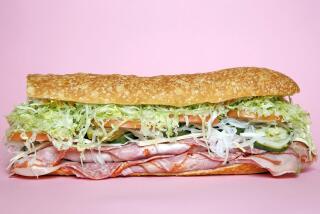Blanching: Critical Step for Frozen Vegetables
- Share via
Blanching, or scalding, is a critical step in preparing fresh vegetables for freezing. This process cleanses the vegetable surfaces of dirt and organisms, brings up their color, helps retain vitamins and reduces the action of enzymes that otherwise would destroy their fresh flavor after about a month in the freezer.
The fresher the vegetables are when frozen, the more satisfactory the end product. Choose those at their peak of ripeness and process them as soon as possible.
Freezing retards the growth of bacteria but does not sterilize the food. Therefore, sanitary measures in the handling and processing of foods are very important.
Before blanching, wash, drain, sort, trim and cut the vegetables the same as you would if you were cooking them fresh. Use one gallon of water to blanch each pound of vegetables--two gallons for a pound of leafy greens.
It’s All in the Timing
Place the vegetables in a wire basket and lower it into vigorously boiling water (Step 1). Begin counting the blanching time as soon as the vegetables enter the water. Keep the heat on high and stir the water or cover the container during blanching.
Time the blanching carefully, using the following chart. Under-blanching stimulates enzyme activity rather than reducing it; prolonged scalding causes loss of vitamins, minerals, flavor and color.
Remove the vegetables from the boiling water and immediately plunge into ice water (Step 2) to stop the cooking process. Stir the vegetables as they cool for approximately the same amount of time they were blanched. If more than one batch of vegetables is being prepared, the hot vegetables may be poured into a colander set in the ice water so the wire basket can be reused.
Airtight Packaging
Pack the cooled vegetables loosely into moisture-and-vapor-proof containers (Step 3). Seal, label with the contents and date (Step 4), then place the containers in a single layer in the freezer, leaving about one inch of space between the packages so they freeze quickly. Once completely frozen, packages may be compactly stacked. Frozen vegetables should be used within one year.
When large quantities of vegetables are being processed, determine the amount that can be blanched in 15 minutes and keep the remainder under refrigeration until the first batch has been packaged. The same scalding water may be reused for the same product, adding water as needed to retain the proper level.
The following timetable for blanching vegetables prior to freezing comes from the “Handbook of Food Preparation,” published by the American Home Economics Assn.
Asparagus Small stalks--2 minutes Medium stalks--3 minutes Large stalks--4 minutes
Beans, lima Small beans or pods--2 minutes Medium beans or pods--3 minutes Large beans or pods--4 minutes
Beans, green or wax--3 minutes
Beets Small--25 to 30 minutes Medium--45 to 50 minutes
Broccoli florets (1 1/2 inches)--3 minutes
Brussels sprouts Small heads--3 minutes Medium heads--4 minutes Large heads--5 minutes
Cabbage, coarse shreds or thin wedges--1 1/2 minutes
Carrots Small whole--5 minutes Diced, sliced, strips--2 minutes
Cauliflower, 1 inch pieces--3 minutes
Celery, 1 inch lengths--3 minutes
Corn, sweet, on the cob Small ears (1 1/4-inches or less in diameter)--7 minutes Medium ears (1 1/4 to 1 1/2 inches in diameter)--9 minutes Large ears (over 1 1/2 inches in diameter)--11 minutes Whole kernel and cream style--4 minutes (cooking time before kernels are cut off cob)
Greens Beet, chard, kale, mustard, spinach, turnip--2 minutes Collards--3 minutes
Kohlrabi 1/2-inch cubes--1 minute Whole, small to medium in size--3 minutes
Okra Small pods--3 minutes Large pods--4 minutes
Parsnips, 1/2-inch cubes or slices--2 minutes
Peas Black-eyed--2 minutes Green--1 1/2 minutes
Peppers Halves--3 minutes Slices--2 minutes
Pumpkin--until soft
Rutabagas, 1/2-inch cubes--2 minutes
Squash Tender-skinned--3 minutes Hard-shelled--until soft
Sweet potatoes--until almost tender
Tomato juice (simmer tomatoes)--5 to 10 minutes
Turnips, 1/2-inch cubes--2 minutes
Note: It is not necessary to blanch rhubarb, peppers, onions and herbs used exclusively for flavoring.
Suggestions for column topics may be sent to Back to Basics, Food Section, The Times, Times Mirror Square, Los Angeles 90053.
More to Read
Eat your way across L.A.
Get our weekly Tasting Notes newsletter for reviews, news and more.
You may occasionally receive promotional content from the Los Angeles Times.










